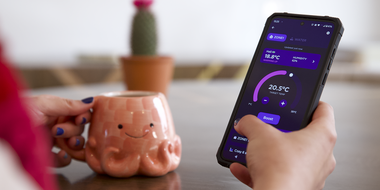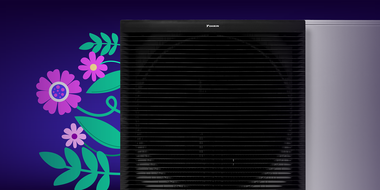Heat pump support
Welcome to the future of home heating!
Here you’ll find everything you need to run your heat pump efficiently, troubleshoot common issues, and get support when you need it. Whether you have a Cosy or Daikin heat pump, we’ve got you covered.
Cosy heat pump support

Controls guidance, troubleshooting and support

Handy screenshots and how-tos for the app

Get to know your Cosy and download the user guide. It covers everything in one place.
Daikin heat pump support

Need a walkthrough of the app?

Want to see control walkthroughs and settings? Download this handy guide.
Make the most of your heat pump
Your heat pump works hard so you don’t have to. With a few simple tweaks, you can keep your home cosy, save energy, and cut costs. Check out our guides for tips on schedules, temperature settings, and getting the most from your smart tariff.

Plan your heating and hot water with ease

Tips for comfort and savings
Make every litre count
5 top tips for getting to know your heat pump
1. It adjusts to the weather
Your heat pump automatically responds to outdoor temperatures to maintain comfort indoors.
2. It warms up gradually
Unlike boilers, heat pumps heat slowly. Set schedules ahead of time to ensure warmth when you need it.
3. Hot water takes priority
When heating water, your system temporarily pauses space heating. It’ll resume once your cylinder is full.
4. Don’t turn it off - just turn it down
Keeping it running steadily is more efficient than frequent shutdowns.
5. Keep it clear and clean
Make sure the outdoor unit is free of leaves, snow, or clutter. Wipe it down occasionally with a damp cloth (no chemicals!).
How to save energy & money
- Stick to a steady temperature
Avoid cranking up the heat. A consistent target temperature that suits your comfort and budget is more efficient than big changes. Your heat pump will adjust automatically to the weather outside.
Check out this guide for tips on the most affordable ways to run your heat pump.
- Set a schedule
Turning your heat pump on and off will use more energy than setting a schedule in advance. It’s designed to work efficiently in the background - even when it’s not actively heating.
Hot tip: On a tariff with peak/off-peak rates? Schedule your heating and hot water during cheaper times to cut costs.
Find recommended schedules here.
- Avoid boost mode
Use it only when truly needed. It’s not the most efficient way to use your system. So it's best to save it for when it’s really needed. - Use a smart tariff
A smart tariff like Cosy Octopus helps you use electricity when it’s greenest and cheapest. It’s designed for heat pump users to save money while staying cosy.
Choosing the right tariff
Heat pump running costs vary, but on a smart, green tariff like Cosy Octopus, many customers save hundreds each year compared to a standard gas boiler tariff. Find out more here.

Designed especially for heat pump owners, Cosy Octopus gives you six hours of super cheap electricity to warm your home every day.

If you have other tech at home like solar panels or an EV, we have the money-saving tariff for you.
Keep your heat pump in tip-top shape
A well-maintained heat pump is a happy heat pump. Our Heat Pump Service Plans make it easy to keep your system running efficiently, avoid unexpected issues, and extend its lifespan. Check out the plans to see what’s included and find the right level of care for your home.
Contact us
Still need help? Get in touch.
Submit a support request: here
Call us: 0808 196 6842
Our aftercare phone lines are open 8am – 8pm Monday to Saturday, 10am - 6pm Sunday.
There are other ways to get in touch too.
If you'd like to raise a formal complaint, find our complaints procedure here.
Common aftercare queries & fixes
Cold Radiators / Low Flow
Heat pumps run a bit cooler than boilers, so your radiators might feel less toasty than you expect - especially on cooler days.
- Cosy: Make sure radiators are bled, schedules are set correctly, and all thermostatic radiator valves are left open.
- Daikin: Bleed your radiators first.
If rooms are still chilly, just submit a support request and we'll help.
Hub Lights & Controls
Cosy hub lights are your window into what your system is up to - think of them as little status updates in light form.
- Cosy: Check the Get to Know Your Cosy PDF for full details.
- Daikin: No hub lights here, so nothing to worry about.
Noises in System or Cylinder
A little gurgle or pop is normal. Loud clunks of constant bubbling? Not so much.
- Try bleeding radiators first to get rid of trapped air (how to bleed a radiator).
- Still noisy? Raise a support request and we'll take a closer look.
Water Issues & Leaks
Water should flow freely from below your heat pump.
- Check the drip tray outlet for debris or ice.
- Spot a puddle or ongoing leak? Contact us straight away - don’t try to fix it yourself. Safety first!
Low Pressure
It’s normal for system pressure to drop over time - usually about once a year you might need to top-up.
- If pressure keeps dropping or stays low after a top-up, submit a support request.
Wi-Fi & Connectivity
- Cosy: Changed broadband? You’ll need a new connection card - just submit a support request and we’ll get one sent to you.
- Daikin: Follow the guide to reconnect your unit to Wi-Fi and make sure your tank is set to Hot Water, Operation: ON.
Hot Water Issues
Double-check your hot water timings (Cosy: Cosy schedule guide.). If it’s still not heating, just submit a support request and we’ll help.
Incorrect Thermostat / Stats Reading
Moving thermostats or placing them somewhere sunny, draughty, or near a radiator can confuse them.
- Keep them in their installed spots.
- If readings still feel off, contact us and we’ll help.
No Power to Unit
- First, check if the rest of your home has power.
- Inspect fuses or circuit breakers if everything else is fine.
- If the unit still won’t turn on, submit a support request- we’ve got you covered.
Disinfection Cycle
Your system might heat water to around 60°C now and then for hygiene. Totally normal - no action needed!
More ways to save
Pair with solar, battery, or an EV charger.

Hey I'm Constantine, welcome to Octopus Energy!
×Close window
